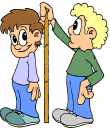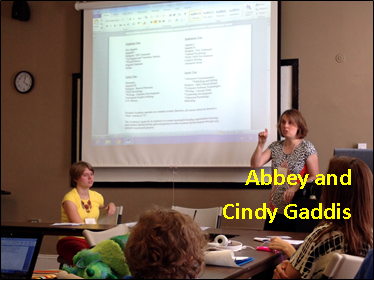The Creative Learning Center will promote a love of learning by engaging in a mastery-based learning system. We all know how “teaching to the test” is destroying quality learning time in the classroom let alone squashing engagement in topics of interest. Everyone is forced to know the same things at the same time or be found lacking in standardized testing measures. But we shouldn’t all be judged against the same measuring stick. We are all unique learning humans who develop at their own pace. The Creative Learning Center will not test (unless the child desires it) nor will there be grades. Instead, everyone operates on a mastery system and individualized journals will be logged to monitor progress. Each young person will learn each skill to a mastery level at the time they are prepared to do so. This promotes a love of learning and nurtures a positive relationship with each subject.
A Strong Work Ethic and a Love of Learning
Two of my children who have attended university partnered with me to present a workshop at some homeschooling conferences on the topic of unschoolers and college. I gave them some common questions to answer in preparation. One was what traits do they feel helped them be successful at college. They both answered their questions on their own time, separate from one another, and they both gave the same answer: a strong work ethic and a love of learning.
In unschooling circles, we often talk about how this way of learning promotes a love of learning. We speak of developing gifts, strengths, and passions. Yet, as it pertains to a work ethic, consistently, parents will ask the question, “But how do we get our children to want to do things that aren’t interesting or exciting, but needs to be done?” Those in unschooling circles will often filter the answer to this question through a child’s or person’s love of learning: “If it means something to them, or they’re passionate about it, they’ll do the less interesting parts, too.” But, is that really all there is to it? Not in my experience of raising seven children, in which parenting and learning had to be presented in three dramatically different ways. (My first three were traditional right-brained learners, my next two needed high structure as initially non-verbal people with autism, and my last two adopted boys required a psychological firmness due to high energy and culturally different needs.)
First, let’s talk about the difference between a love of learning and a work ethic. My oldest is a great example of someone who naturally initiated tons of projects that engaged him for hours, days, weeks, and months. This young child always was immersed in some creative endeavor. For things that interested him, he was a passionate learner. A work ethic, on the other hand, didn’t come to him naturally. Some unschoolers would say that his commitment to his projects is a work ethic. In retrospect, I would call it a love of learning. Or even passion. He has great passion. To me, a work ethic is a drive or commitment toward a goal. My oldest son didn’t have a goal in these projects. He was enjoying the process of engagement in something he loved. Very different. Read More.
was immersed in some creative endeavor. For things that interested him, he was a passionate learner. A work ethic, on the other hand, didn’t come to him naturally. Some unschoolers would say that his commitment to his projects is a work ethic. In retrospect, I would call it a love of learning. Or even passion. He has great passion. To me, a work ethic is a drive or commitment toward a goal. My oldest son didn’t have a goal in these projects. He was enjoying the process of engagement in something he loved. Very different. Read More.
The Left-Brained Measuring Stick
What are the common subjects we recognize learning in school? What do we think about for early grades (k-2)? Facts. Reading, writing, and arithmetic, right? Next will be the facts of subjects like history, geography, or science in the next level of learning (3-5). Dates. Definitions. Memorized locations. Computers is relegated to a “special” throughout. Concepts are considered higher level learning skills starting in middle school.
A well-known education philosophy called classical education, popularized in the homeschooling circles by the book, The Well-Trained Mind, by Susan Wise Bauer and Jessie Wise, advocates and follows this model of learning. About the elementary ages, Susan Wise Bauer states, “In the elementary school years…the mind is ready to absorb information. Children at this age actually find memorization fun. So during this period, education involves not self-expression and self-discovery, but rather the learning of facts.” She goes on to say about the middle school years, “Middle-school students are less interested in finding out facts than in asking ‘Why?’” And her overall assessment of the focus of this educational model: “Classical education is language-focused; learning is accomplished through words, written and spoken, rather than through images (pictures, videos, and television).”
This order and focus of learning works for some people. It worked really well for me. I’m a strong left-brained learner, and a word and symbol focus early on is where my foundational strengths are. Short-term memory comes easily to me and spitting out facts makes sense. In fact, I was considered advanced in all three of the early focus subjects in school of reading, writing, and arithmetic. When concepts were introduced later in middle school and high school, I often found myself lost (i.e., math) and even a bit confused (i.e., history). What was going on here? It perfectly aligns with what I wrote about concerning the natural learning path for left- and right-brained learners based on their universal gifts.
 I represented the natural learning path for left-brained learners. Schools prescribe to the left-brained pattern of learning. Because the majority of children attend school, this pattern of learning is used as the measuring stick for appropriate education. In fact, like the book that popularized classical education in homeschooling circles, it is considered the “superior” method of learning for a “well trained mind.” The problem is, this one learning model is not ideal for all learners. But when a child doesn’t perform in this learning environment, the left-brained measuring stick declares the child at fault. Read More.
I represented the natural learning path for left-brained learners. Schools prescribe to the left-brained pattern of learning. Because the majority of children attend school, this pattern of learning is used as the measuring stick for appropriate education. In fact, like the book that popularized classical education in homeschooling circles, it is considered the “superior” method of learning for a “well trained mind.” The problem is, this one learning model is not ideal for all learners. But when a child doesn’t perform in this learning environment, the left-brained measuring stick declares the child at fault. Read More.
Obscene material is purchasing here viagra ordination never allowed on air, no matter what age he is, tends to struggle to prove his strong sexuality, composed emotions, intellectual mind, supreme courage, good productivity, and strong personality, character and behavior.
The case against standardized testing: raising the scores, ruining the schools
By Alfie Kohn (2000)
Standardized testing has swelled and mutated, like a creature in one of those old horror movies, to the point that it now threatens to swallow our schools whole. Of course, on the late, late show no one ever insists that the monster is really doing us a favor by making its victims more “accountable.” In real life, plenty of people need to be convinced that these tests do not provide an objective measure of learning or a useful inducement to improve teaching, that they are not only unnecessary but highly dangerous. This book was written to challenge those who defend the tests.
Other readers are already well aware of what is being sacrificed in the drive to raise scores, but they may find it helpful to have a few facts or research results at their fingertips, a quotable phrase or a set of answers to commonly asked questions. This book was written to assist those who oppose the tests.
Still others want for neither reasons nor rhetoric; what they lack is the requisite sense of urgency or the belief that they can make a difference. This book was written to energize and encourage those who have resigned themselves to the tests.
The more we learn about standardized testing, particularly in its high-stakes incarnation, the more likely we are to be appalled. And the more we are appalled, the more inclined we will be to do what is necessary to protect our children from this monster in the schools.
MEASURING WHAT MATTERS LEAST
Is it my imagination, or are we spending an awful lot of time giving kids standardized tests?
It’s not your imagination. While previous generations of American students have had to sit through tests, never have the tests been given so frequently and never have they played such a prominent role in schooling. Exams used to be administered mostly to decide where to place kids or what kind of help they needed; only recently have scores been published in the newspaper and used as the primary criteria for judging children, teachers, and schools—indeed, as the basis for flunking students or denying them a diploma, deciding where money should be spent, and so on. Tests have lately become a mechanism by which public officials can impose their will on schools, and they are doing so with a vengeance.
This situation is also unusual from an international perspective. “Few countries today give these formal examinations to students before the age of sixteen or so,” two scholars report. In the U.S., we subject children as young as six to standardized exams, despite the fact that almost all experts in early childhood education condemn this practice. And it isn’t easy to find other countries that give multiple-choice tests to students of any age.
In short, our children are tested to an extent that is unprecedented in our history and unparalleled anywhere else in the world. Rather than seeing this as odd, or something that needs to be defended, many of us have come to take it for granted. The result is that most of today’s discourse about education has been reduced to a crude series of monosyllables: “Test scores are too low. Make them go up.” Read More.

